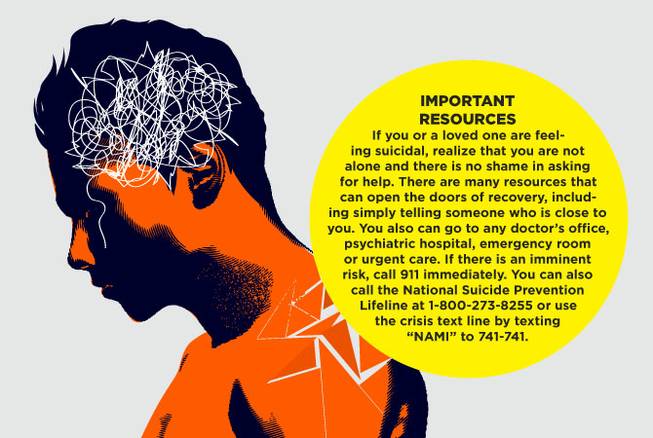
Monday, July 31, 2017 | 2 a.m.
Mental illness has no boundaries and can affect anyone, regardless of age, gender, race and income level. The National Alliance on Mental Illness reports that approximately 1 in 5 adults in the United States experience mental illness in any given year, and suicide is the 10th-leading cause of death in the U.S.
Despite its commonality, mental illness and suicide can be difficult for people to discuss, and there are many misunderstandings about the topic.
There is still a widespread misconception that talking about suicide with someone who is depressed will make him or her more likely to commit suicide, say Jonathan Still, MD, and Jonathan Wirjo, DO, psychiatrists at Focus Mental Health Solutions, and psychiatric services provider at Southern Hills Hospital and Medical Center. “In fact, talking about it helps spread awareness in patients and their families — including warning signs of suicide and appropriate interventions,” Still said.
While suicide can be scary and unsettling, the better we’re able to discuss it as a community, the sooner we’ll be able to demystify the topic and recognize the warning signs for people who are suffering.
Why do people commit suicide?
Suicide is deeply personal and it’s impossible to say what drives a particular individual to take his or her own life, though it’s often linked to mental illness.
“Both suicide and suicidal thoughts are almost always the result of mental illness, which is amenable to psychological and pharmacological treatment,” Still said. “Mental illnesses commonly associated with suicide include depression, bipolar disorder, anxiety, substance use disorders and schizophrenia.”
Some people may commit suicide or other acts of self-harm impulsively, whereas others may experience suicidal thoughts for days, months and even years prior. “In general, suicide may occur when a person’s body and natural stress-response systems become overwhelmed to the point that any additional stress or burden is unfathomable,” Still said.
The impact of suicide
44,193 Americans die by suicide annually. That’s about 121 people a day. For every death by suicide, there are 25 attempts.
Women are more likely to attempt suicide, but men are four times more likely to die by suicide.
In 2015, approximately 20 percent of all suicides were among Native Americans, 17 percent were among whites, 5.8 percent were among Hispanics, 6.4 percent were among Asian and Pacific Islanders, and 5.6 percent were among blacks.
In 2015, Nevada was ranked 11th in the U.S. for number of suicides.
The American Foundation for Suicide Prevention notes that while these statistics represent some of the most accurate data available, the numbers may actually be higher because the stigma surrounding suicide leads to underreporting and insufficient data collection methods.
Misconceptions about suicide
There are many misconceptions about suicide, including that suicidal people feel as if they have nothing to live for, which is often not the case.
“There is a common misconception that suicidal people want to die. Rather, in many cases, people express the desire to escape the pain they’re feeling,” Still said. It’s important to know that mental illnesses of all kinds can be successfully treated with the help of professional intervention.
Though recovery can seem daunting, it is absolutely possible.
Warning signs and risk factors
Oftentimes, a suicidal person will show warning signs to indicate they’re struggling prior to their attempt.
“People should be aware of those around them who are exhibiting signs of mental illness, whether or not they’re in treatment,” Still said. “Above all, be aware of changes in behavior in people you know or care about. In many instances, family, friends or close associates can take notice of these changes and initiate the process of getting someone help.”
Common warning signs and risk factors include:
• Depression
• Isolation
• Lack of energy/motivation
• Loss of interest, especially in activities they normally enjoy
• Decrease of appetite
• Sleep dysfunction
• Feelings of hopelessness, worthlessness and/or feeling trapped
• Experiencing chronic pain
• Aggression/rage/irritability
• Anxiety
• Increased use of drugs or alcohol
• Reckless behavior
• Dramatic mood swings
• Statements regarding their mental state, including talking about suicide and their suicidal thoughts
• Intoxication (more than 1 in 3 people who die from suicide are intoxicated at the time)
• History of trauma
• Recent tragedy or loss
Important resources
If you or a loved one are feeling suicidal, realize that you are not alone and there is no shame in asking for help. There are many resources that can open the doors of recovery, including simply telling someone who is close to you.
You can go to any doctor’s office, psychiatric hospital, emergency room or urgent care. If there is an imminent risk, call 911 immediately. You can also call the National Suicide Prevention Lifeline at 1-800-273-8255 or use the crisis text line by texting “NAMI” to 741-741.

Join the Discussion:
Check this out for a full explanation of our conversion to the LiveFyre commenting system and instructions on how to sign up for an account.
Full comments policy